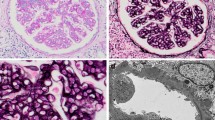Abstract
Dense deposit disease (DDD, formerly known as membranoproliferative glomerulonephritis (MPGN) type II) is a subtype of C3 glomerulopathy (C3G). Electron-dense deposits in the glomerular basement membrane characterize this glomerulonephritis. DDD typically presents with a nephritic syndrome that progresses to end-stage renal failure in 50 % of patients despite treatment. The pathogenic basis of DDD is uncontrolled activation of the alternative complement cascade although the potential triggering events that precipitate the development of complement dysregulation are typically unknown. There are isolated reports of an apparent association between streptococcal infection and DDD, as well as with MPGN types I and III. However, this association has not been deemed compelling, perhaps because so few cases have been reported or because of a current lack of evidence for a plausible hypothesis to connect a streptococcal infection with subsequent disease. In this report, we describe two patients with DDD who definitely had an antecedent streptococcal infection with the phenotype of acute post-streptococcal glomerulonephritis and whose initial kidney biopsy findings on light microscopy were indistinguishable from acute post-streptococcal glomerulonephritis. These patients had additional points of interest: recurrence of gross hematuria with recurrent streptococcal infections, slowly progressive course, persistently low serum C3 concentration, positive C3 nephritic factor, and positive risk alleles in the complement factor H (CFH) gene. Conclusion: We suggest that streptococcal infection may trigger DDD in individuals genetically predisposed by virtue of a disorder in complement regulation.



Similar content being viewed by others
References
Abrera-Abeleda MA, Nishimura C, Smith J, Sethi S, McRae J, Murphy B, Silvestri G, Skerka C, Jozsi M, Zipfel P, Hageman G, Smith R (2006) Variations in the complement regulatory genes factor H (CFH) and factor H related 5 (CFHR5) are associated with membranoproliferative glomerulonephritis type II (dense deposit disease). J Med Genet 43(7):582–589
Alchi B, Jayne D (2010) Membranoproliferative glomerulonephritis. Pediatr Nephrol 25:1409–1418
Appel G, Cook H, Hagerman G, Jennette J, Kashgarian M, Kirschfink M, Lambris J, Lanning L, Lutz H, Meri S, Rose N, Salant D, Sethi S, Smith R, Smoyer W, Tully H, Tully S, Walker P, Welsh M, Wurzner R, Zipfel P (2005) Membranoproliferative glomerulonephritis type II (dense deposit disease): an update. Am Soc Nephrol 16:1392–1403
Batsford S, Mezzano S, Mihatsch M, Schiltz E, Rodriguez-Iturbe B (2005) Is the nephritogenic antigen in post-streptococcal glomerulonephritis pyrogenic exotoxin B (SPE B) or GAPDH? Kidney Int 68:1120–1129
Cansick J, Lennon R, Cummins C, Howie A, McGraw M, Saleem M, Tizard E, Hulton S, Milford D, Taylor C (2004) Prognosis, treatment and outcome of childhood mesangiocapillary (membranoproliferative) glomerulonephritis. Nephrol Dial Transplant 19:2769–2777
D'Agati V, Bomback A (2012) C3 glomerulopathy: what’s in a name? Kidney Int 82:379–381
Fremeaux-Bacchi V, Weiss L, Demouchy C, May A, Palomera S, Kazatchkine M (1994) Hypocomplementaemia of poststreptococcal acute glomerulonephritis is associated with C3 nephritic factor (C3NeF) IgG autoantibody activity. Nephrol Dial Transplant 9(12):1747–1750
Kambham N (2012) Postinfectious glomerulonephritis. Adv Anat Pathol 19(5):338–347
Kasahara T, Hayakawa H, Okubo S, Okugawa T, Kabuki N, Tomizawa S, Uchiyama M (2001) Prognosis of acute poststreptococcal glomerulonephritis (APSGN) is excellent in children, when adequately diagnosed. Pediatr Int 43:364–367
Kerns E, Rozansky D, Troxell ML (2013) Evolution of immunoglobulin deposition in C3-dominant membranoproliferative glomerulopathy. Pediatr Nephrol 28(11):2227–2231
Licht C, Fremeaux-Bacchi V (2009) Hereditary and acquired complement dysregulation in membranoproliferative glomerulonephritis. Thromb Haemost 2:271–278
Rodriguez-Iturbe B, Batsford S (2007) Pathogenesis of poststreptococcal glomerulonephritis a century after Clemens von Pirquet. Kidney Int 71:1094–1104
Sawanobori E, Umino A, Kanai H, Matsushita K, Iwasa S, Kitamura H, Oda T, Yoshizawa N, Sugita K, Higashida K (2009) A prolonged course of Group A streptococcus-associated nephritis: a mild case of dense deposit disease (DDD)? Clin Nephrol 6:703–707
Servais A, Noël LH, Roumenina LT, Le Quintrec M, Ngo S, Dragon-Durey M, Macher M, Zuber J, Karras A, Provot F, Moulin B, Grunfeld J, Niaudet P, Lesavre P, Fremeaux-Bacchi V (2012) Acquired and genetic complement abnormalities play a critical role in dense deposit disease and other C3 glomerulopathies. Kidney Int 82(4):454–464
Sethi S, Fervenza FC, Zhang Y, Zand L, Meyer NC, Borsa N, Nasr SH, Smith RJH (2013) Atypical post-infectious glomerulonephritis is associated with abnormalities in the alternative pathway of complement. Kidney Int 83(2):293–299
Sethi S, Nester CM, Smith RJ (2012) Membranoproliferative glomerulonephritis and C3 glomerulopathy: resolving the confusion. Kidney Int 81:434–441
Shahidi-Asl M, Ananth M, Boineau F, Meleg-Smith S (2000) Apparent progression of acute glomerulonephritis to dense deposit disease. Ultrastruct Pathol 24:273–277
Suga K, Kondo S, Matsuura S, Kinoshita Y, Kitano E, Hatanaka M, Kitamura H, Hidaka Y, Oda T, Kagami S (2010) A case of dense deposit disease associated with a group A streptococcal infection without the involvement of C3NeF or complement factor H deficiency. Pediatr Nephrol 25:1547–1550
Uchida T, Oda T, Watanabe A, Izumi T, Higashi K, Kushiyama T, Miura S, Kumagai H (2011) Clinical and histologic resolution of poststreptococcal glomerulonephritis with large subendothelial deposits and kidney failure. Am J Kidney Dis 58:113–117
Vernon K, Goicoechea de Jorge E, Hall A, Fremeaux-Bacchi V, Aitman T, Cook H, Hangartner R, Koziell A, Pickering M (2012) Acute presentation and persistent glomerulonephritis following streptococcal infection in a patient with heterozygous complement factor H-related protein 5 deficiency. Am J Kidney Dis 60(1):121–125
Conflict of interest
We certify that we have nothing to disclose. There is no conflict of interest with any financial organization regarding the material discussed in the manuscript.
Author information
Authors and Affiliations
Corresponding author
Rights and permissions
About this article
Cite this article
Prasto, J., Kaplan, B.S., Russo, P. et al. Streptococcal infection as possible trigger for dense deposit disease (C3 glomerulopathy). Eur J Pediatr 173, 767–772 (2014). https://doi.org/10.1007/s00431-013-2245-7
Received:
Accepted:
Published:
Issue Date:
DOI: https://doi.org/10.1007/s00431-013-2245-7




